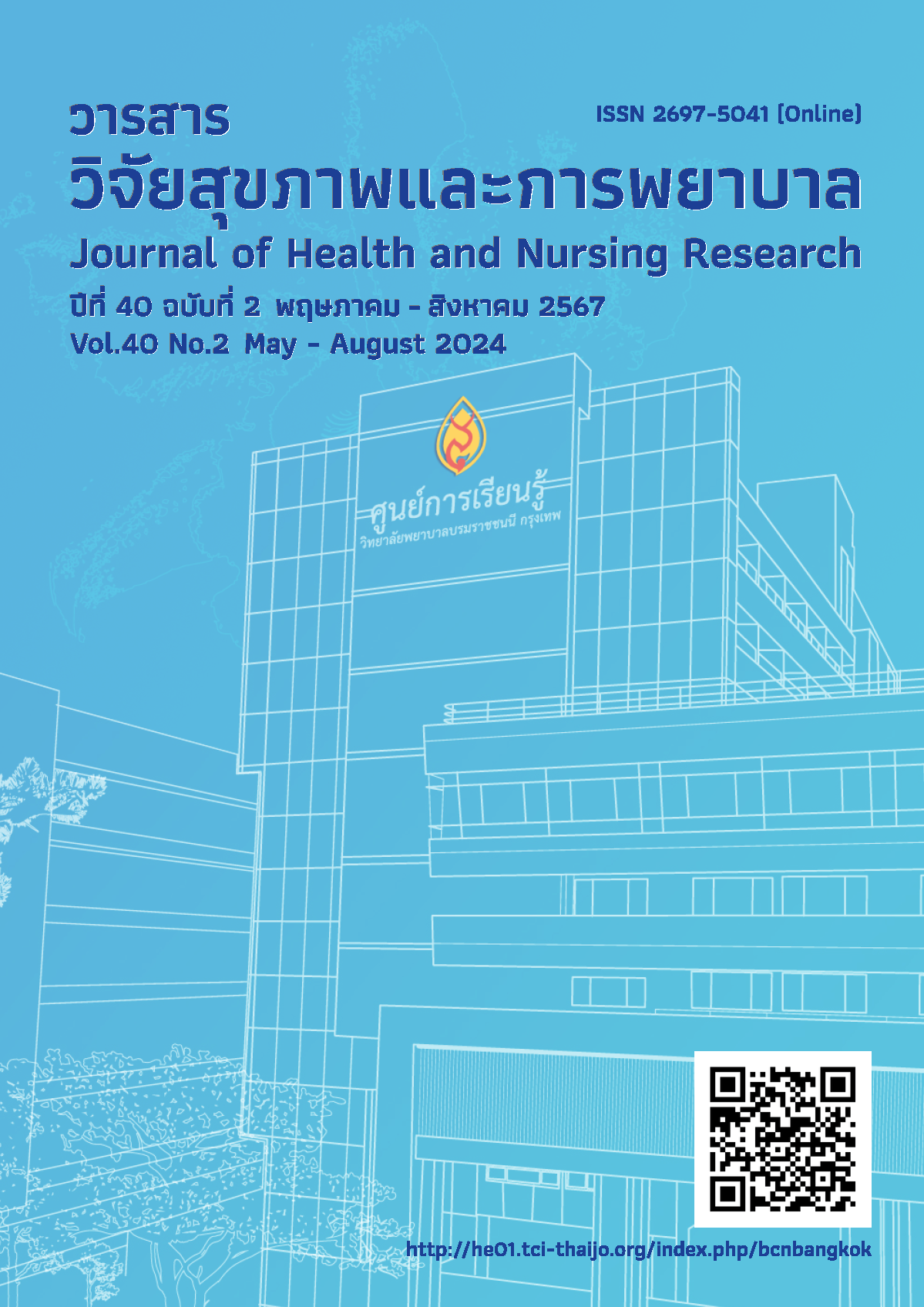ผลของการใช้แนวคิด สบช. โมเดล ในการป้องกันและควบคุมโรคไม่ติดต่อเรื้อรัง ของประชาชนอำเภอเมือง จังหวัดพะเยา
คำสำคัญ:
โรคไม่ติดต่อเรื้อรัง, สบช. โมเดล , โรคเบาหวาน, โรคความดันโลหิตสูงบทคัดย่อ
บทนำ: โรคไม่ติดต่อเรื้อรังเป็นสาเหตุการเสียชีวิตที่สำคัญไปทั่วโลก ดังนั้น การคัดกรอง ป้องกันและควบคุมยังคงเป็นวิธีการที่ดีที่สุดในการจัดการโรคเหล่านี้ แนวคิดสถาบันพระบรมราชชนก โมเดล หรือ สบช. โมเดล เป็นวิธีการจัดการโรคไม่ติดต่อเรื้อรังที่มีประสิทธิภาพในปัจจุบัน
วัตถุประสงค์การวิจัย: เพื่อศึกษาเปรียบเทียบความรู้ ทัศนคติ และทักษะการป้องกันและควบคุมโรคไม่ติดต่อเรื้อรัง ก่อนและหลังการใช้แนวคิด สบช. โมเดล และศึกษาเปรียบเทียบค่าความดันโลหิตตัวบน ค่าความดันโลหิตตัวล่างและระดับน้ำตาลในเลือด ก่อนและหลังการใช้แนวคิด สบช. โมเดล ของประชาชนอำเภอเมือง จังหวัดพะเยา
ระเบียบวิธีวิจัย: การวิจัยแบบกึ่งทดลอง กลุ่มเดียววัดผลก่อน - หลัง กลุ่มตัวอย่าง 702 ราย คัดเลือกโดยการสุ่มอย่างง่าย รวบรวมข้อมูลระหว่างเดือนเมษายน ถึงพฤศจิกายน 2566 เครื่องมือที่ใช้ในงานวิจัยครั้งนี้ เป็นแบบสอบถามที่พัฒนาขึ้นจากการทบทวนวรรณกรรม โดยตรวจสอบความตรงของเนื้อหาจากผู้ทรงคุณวุฒิ 5 ท่าน ได้เท่ากับ .94
และตรวจสอบความเชื่อมั่นของเครื่องมือแบบสอบถามความรู้ และแบบสอบถามทัศนคติ และทักษะการป้องกันและควบคุมโรคไม่ติดต่อเรื้อรัง ได้เท่ากับ .97, .87 และ .87 ตามลำดับ วิเคราะห์ข้อมูลโดยใช้สถิติเชิงพรรณนา และเปรียบเทียบก่อน - หลังโดยใช้สถิติ Paired Sample t - test
ผลการวิจัย: เมื่อเปรียบเทียบก่อน - หลังการใช้แนวคิด สบช. โมเดล พบว่า กลุ่มตัวอย่างมีค่าเฉลี่ยความดันโลหิตตัวบน (ค่าเฉลี่ยก่อน = 131.94, ค่าเฉลี่ยหลัง = 128.71, p < .001) ค่าเฉลี่ยความดันโลหิตตัวล่าง (ค่าเฉลี่ยก่อน = 79.16, ค่าเฉลี่ยหลัง = 78.08, p < .001) และค่าเฉลี่ยระดับน้ำตาลปลายนิ้ว (ค่าเฉลี่ยก่อน = 100.96, ค่าเฉลี่ยหลัง = 98.71, p < .001) ทุกค่าดีขึ้นอย่างมีนัยสำคัญทางสถิติ นอกจากนี้ยังพบว่า คะแนนเฉลี่ยของความรู้ ทัศนคติ และทักษะการป้องกันควบคุมโรคไม่ติดต่อเรื้อรังเพิ่มขึ้นอย่างมีนัยสำคัญทางสถิติ (p <. 001, p < .001 และ p < .001 ตามลำดับ)
สรุปผล: แนวคิด สบช. โมเดล สามารถนำมาใช้ในการคัดกรอง ป้องกัน และควบคุมความเสี่ยงของโรคไม่ติดต่อเรื้อรังได้อย่างมีประสิทธิภาพ
ข้อเสนอแนะ: บุคลากรด้านสุขภาพสามารถนำแนวคิด สบช. โมเดล ไปประยุกต์ใช้ในการคัดกรองความรุนแรงของโรคอื่น ๆ ในชุมชน เช่น ภาวะซึมเศร้า ภาวะเครียด และภาวะเมทาบอลิกซินโดรม
Downloads
เอกสารอ้างอิง
World Health Organization [WHO]. Non-communicable diseases [Internet]. 2023. [cited 2023 April 20]. Available form: https://www.who.int/news-room/fact-sheets/detail/noncommunicable-diseases
Aekpalakon W. Report: Thai people's health survey by physical examination [internet]. 2022. [cited 2023 April 20]. Available form: https://online.fliphtml5.com/bcbgj/znee/#p=1. (in Thai)
Our World in Data. Daly rates from non-communicable diseases (NCDs) [Internet]. 2022. [cited 2023 April 20]. Available form: https://ourworldindata.org/grapher/burden-of-disease-rates-from-ncds?tab=table.
Thailand Development Research Institute. Study report: Estimates of public health expenditures in the next 15 years Next year [internet]. 2019. [cited 2023 April 20]. Available form: https://tdri.or.th/2019/12/public-healthcare-evaluation. (in Thai)
Thai Health Promotion Foundation. NCDs [Internet]. 2023. [cited 2023 April 20]. Available form: https://www.thaihealth.or.th/?p=228095. (in Thai)
Diabetes Association of Thailand under the Patronage of Her Royal Highness Princess Maha Chakri Sirindhorn. Clinical practice guideline for diabetes 2023 [internet]. 2023. [cited 2023 April 20]. Available form: https://drive.google.com/file/d/1OAIDiCyGsJYA1-wTAxoOu6yL_YL9c7IG/view?usp=sharing. (in Thai)
Thai Hypertension Society. Thai guidelines on the treatment of hypertension 2019. Chiang Mai: trickthink; 2020. (in Thai)
Christe DM, Vijaya S, Tharangini K. Screening for non-communicable diseases. International Journal of Reproduction, Contraception, Obstetrics and Gynecology. 2020;9(3):1092-102.
Vasuthada C, Dechavoot L, Jaikla N, Jarujit S. The relationship between perception toward non-communicable diseases and health promotion behaviors for non-communicable diseases prevention among people in muang district, Chanthaburi province. Journal of Phrapokklao Nursing College 2018;29(2):47-59. (in Thai)
Tienthavorn V. Surveillance, control and prevention system of DM and HT in Thailand: Policy to action. 3th ed. Nonthaburi: The Ministry of Public Health; 2013. (in Thai)
Juwa S, Wongwat R, Manoton A. The effectiveness of the health behavior change program with 7 colors ball tool on knowledge, health belief and behavior related to the prevention and control of hypertension and diabetes mellitus, in Maeka Sub-District, Muang District, Phayao Province. Songklanagarind Journal of Nursing 2019;39(2):127-41. (in Thai)
Turner K, Charoensuk S, Polthana P, Nitirat P, Howharn C. Conceptual framework of health policy for health promotion with PBRI Model by Integrating with higher education missions into healthy communities, faculty of nursing, Praboromarajchanok Institute. Thai Journal of Public Health and Health Sciences. 2022;5(3):204-8. (in Thai)
Chamchan D. Development of a health behavior modification model to reduce the incidence of diabetes among people at risk of diabetes Chonsomboon sub-district heath promoting hospital Nongmuang district Loburi province. Department of Health Service Support Journal. 2022;18(3):47-58. (in Thai)
Jamjumroon P, Phatisena T. Using the 7 colors diabetes mellitus self- awareness evaluation project in preventing and controlling diabetes in subdistrict health promotion hospitals in nakhon ratchasima. Ratchaphruek Journal 2017;15(2):125-34. (in Thai)
Chunchai S, Chumpathat N, Khungtumneum K, Namjuntra R, Amphamani A. Health literacy and health behavior 3E.2S. among patients with diabetes and hypertension in Bang Phi district, Samut Prakan province. Journal of Health and Nursing Research 2022;38(2):235-245. (in Thai)
AYoh N, Sittisart V, Na Wichian S. The effectiveness of health promoting program on behavior modification based on PBRI’s model for patients with hypertension in Samokhae sub-district, Mueang District, Phitsanulok Province. The Journal of Boromarjonani College of Nursing, Suphanburi 2022;5(2):129-39. (in Thai)
Nunta S, Glomjai T, Sajai K, Ananchaipatana N, Pechkwang D, Waengkam W. The effects of a health promotion program based on the PBRI Model on knowledge, attitude, and behavior in preventing non-communicable diseases among students nurse. Journal of Health Research and Innovation 2023;6(2):1-15. (in Thai)
Meenasantirak A, Toontham K. The effects of health promotion by applying the principles of PBRI’s Model in nursing students. Journal of Health and Nursing Education. 2023;29(3):19-36. (in Thai)
Nojai V, Khampeera A, Kajai C, Khumdee B Rimchan K. Effects of Somporn Kantharadussadee Triumchaisri (SKT) meditation on blood glucose levels of pre-diabetes mellitus. Journal of the Royal Thai Army Nurses 2018;19(3):175-84. (in Thai)
Charoenpong C, Jaroenpong J. The effects of health behavior promotion program on health behavior and blood pressure in primary hypertensive patients. Journal of Health and Nursing Research 2022;38(3):71-81. (in Thai)
ดาวน์โหลด
เผยแพร่แล้ว
รูปแบบการอ้างอิง
ฉบับ
ประเภทบทความ
สัญญาอนุญาต
ลิขสิทธิ์ (c) 2024 วารสารวิจัยสุขภาพและการพยาบาล (วารสารวิทยาลัยพยาบาลบรมราชชนนี กรุงเทพ)

อนุญาตภายใต้เงื่อนไข Creative Commons Attribution-NonCommercial 4.0 International License.
บทความที่ได้รับการตีพิมพ์ เป็นลิขสิทธิ์ของวารสารวิจัยสุขภาพและการพยาบาล (วิทยาลัยพยาบาลบรมราชชนนี กรุงเทพ) ไม่สามารถนำไปตีพิมพ์ซ้ำในวารสารฉบับอื่น


















